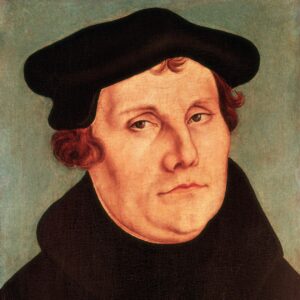Roman emperors and modern dictators have feared the social and spiritual penalties of excommunication.
January 28, 2021
Nowadays, all it takes for a person to be condemned to internal exile is a Twitter stampede of outrage. The lack of any regulating authority or established criteria for what constitutes repentance gives “cancel culture,” as it is popularly known, a particularly modern edge over more old-fashioned expressions of public shaming such as tar-and-feathering, boycotts and blacklists.

Portrait of Martin Luther by Lucas Cranach the Elder.
PHOTO: CORBIS/VCG/GETTY IMAGES
But the practice of turning nonconforming individuals into non-persons has been used with great effectiveness for centuries, none more so than the punishment of excommunication by the Roman Catholic Church. The penalties included social ostracism, refusal of communion and Christian burial, and eternal damnation of one’s soul.
The fear inspired by excommunication was great enough to make even kings fall in line. In 390, soldiers under the command of the Roman emperor Theodosius I massacred thousands in the Greek city of Thessalonica. In response, Bishop Ambrose of Milan excommunicated Theodosius, forcing him to don sackcloth and ashes as public penance. Ambrose’s victory established the Church’s authority over secular rulers.
Later church leaders relied on the threat of excommunication to maintain their power, but the method could backfire. In 1054, Pope Leo III of Rome excommunicated Patriarch Michael Cerularius of Constantinople, the head of the eastern Church, who retaliated by excommunicating Leo and the western Church. Since this Great Schism, the two churches, Roman Catholic and Eastern Orthodox, have never reunited.
During the Middle Ages, the penalty of excommunication broadened to include the cancellation of all legal protections, including the right to collect debts. Neither kings nor cities were safe. After being excommunicated by Pope Gregory VII in 1076, Holy Roman Emperor Henry IV stood barefoot in the snow for three days before the pontiff grudgingly welcomed him inside to hear his repentance. The entire city of Venice was excommunicated over half a dozen times, and on each occasion the frightened Venetians capitulated to papal authority.
But the excommunication of Martin Luther, the founder of Protestantism, by Pope Leo X in January 1521, 500 years ago this month, didn’t work out as planned. Summoned to explain himself at the Diet of Worms, a meeting presided over by the Holy Roman Emperor Charles V, Luther refused to recant and ask forgiveness, allegedly saying: “Here I stand, I can do no other.” In response, the Emperor declared him a heretic and outlaw, putting his life in danger. Luther was only saved from assassination by his patron, Frederick, Elector of Saxony, who hid him in a castle. Luther used the time to begin translating the Bible into German.
Napoleon Bonaparte was equally unconcerned about the spiritual consequences when he was excommunicated by Pope Pius VII in 1809. Nevertheless, he was sufficiently frightened of public opinion to kidnap the pontiff and keep him out of sight for several months. In 1938, angry over Nazi Germany’s takeover of Austria, the Italian dictator Benito Mussolini tried to persuade Pope Pius XI to excommunicate the German dictator Adolf Hitler, a nonpracticing Catholic. Who knows what would have happened if he had been successful.





